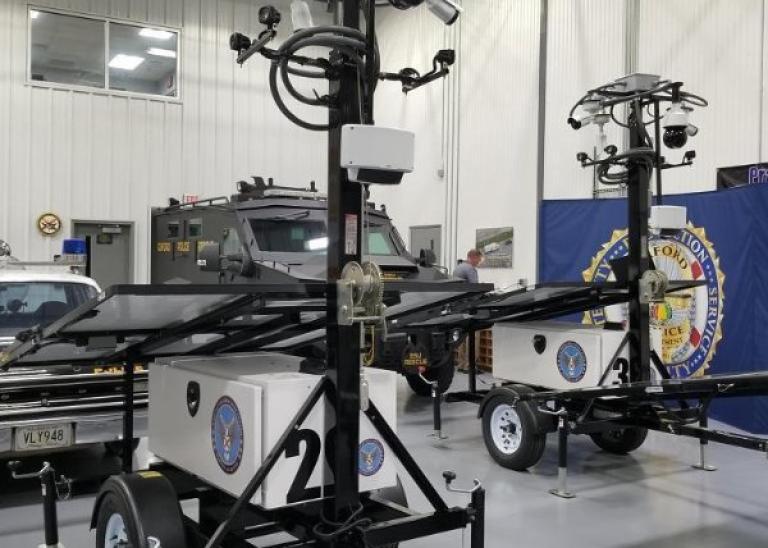5 Ways Law Enforcement Can Extend Its Reach with Remote Monitoring
By ECAMSECURE 10/12/2021

Making the “long arm of the law” longer
Contemporary law enforcement agencies are challenged by a number of gaps: gaps in staffing that leave departments with an insufficient number of officers, gaps in budgets that make acquiring more officers difficult or impossible, and most importantly, gaps in their ability to provide sufficient coverage to all areas of concern. In short: more crime, with fewer resources to fight it.
In response, innovative police departments, such as those in Albuquerque, New Mexico and Oxford, Alabama are extending their reach through remote camera monitoring, a combination of Mobile Surveillance Units (MSUs) and centralized surveillance that can provide more coverage without overburdening precious resources.
The technology is sophisticated, but not complex. Here are the top five ways law enforcement can benefit from MSUs and remote monitoring:
1: PUT EYES ON CRIME HOT SPOTS
As the name suggests, Mobile Surveillance Units (MSU) are inherently portable surveillance platforms, either mounted on poles or supported on wheeled trailers, that can be placed where they are most needed. Remote locations, abandoned property, crowded public events, challenging urban environments: each one of these can be addressed by an MSU that serves as 24/7 “eyes” – regardless of climate or weather – anywhere it would be impractical to deploy an active police patrol.
2: ASSERT A VISUAL PRESENCE
In addition to being eyes that see, the MSU is an assertive presence that can be seen as well, reassuring ordinary citizens of their safety while discouraging criminal activity. Each unit can not only carry mobile surveillance cameras, but lights – including flashing blue lights – that make its presence inescapable. In Oxford, Alabama, the placement of an MSU in a key retail environment during the holiday season reduced vehicle B&Es (breaking and entering) from the previous season’s fifty-two violations down to ZERO.
3. CENTRALIZE COMMAND WITHIN A CCTV OR REAL-TIME CRIME CENTER (RTCC)
MSUs can be easily incorporated within a department’s command post as part of a mobile CCTV surveillance system. However, some more forward-thinking agencies participate in regional Real-Time Crime Centers that acknowledge the fluid and cross-jurisdictional impacts of crime. By collaborating with multiple agencies, departments can share critical information faster, allowing them to take more proactive approaches to emerging trouble spots.
4. APPLY INTELLIGENCE-LED POLICING (ILP)
The MSU/RTCC combination can do so much more than conduct live video monitoring or record forensic evidence. Through advanced algorithms and machine learning, ECAMSECURE technology alerts command center operators to video recorded events that merit closer review. This layer of intelligence overcomes the impossible challenge of 24/7 visual monitoring by command center staff; over time, as the technology “learns” from previous experience, the number of false positives decline as its quality of its results improve.
5. ENJOY FLEXIBILITY OF TECHNOLOGY, LOCATION AND MORE
Serving as virtual security guards that reinforce live patrols, remote monitoring through MSUs and command centers offers an unusual degree of flexibility unavailable through other options. The MSUs, for example, can not only carry traditional video cameras, but can support pan/tilt/zoom (PTZ) cameras, thermal cameras, and technology for facial and/or license plate recognition. In addition to cameras, MSUs can support lights, two-way audio and other features that reinforce a department’s law enforcement presence.
As mentioned earlier, MSUs can be easily redeployed to areas of concern at short notice. Again, the solution is flexibility: MSUs can be powered by electricity on-site, solar panels, and/or with diesel generators to ensure continuity of presence and uninterrupted recording.
Solutions are ready and available now
The challenges – stubborn crime, insufficient budgets – are all too real. But even though “virtual guard services,” “remote monitoring,” and “intelligence-led policing” sound futuristic, they are every bit as real and practical as the challenges.
At ECAMSECURE, we have had the satisfaction of helping law enforcement agencies apply proven technology to overcome daunting resource and budget issues. Our MSUs and associated artificial intelligence are working, right now, to reduce crime and increase citizen confidence.


